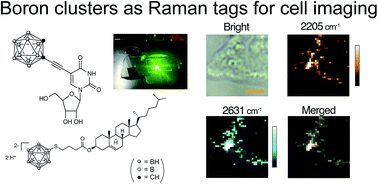Raman cell imaging with boron cluster molecules conjugated with biomolecules†
Abstract
Raman spectroscopic measurements and theoretical calculation revealed that the Raman bands corresponding to the B–H stretching vibrations of two types of simple icosahedral boron clusters, ortho-carborane 3 and closo-dodecaborate 4 appeared at approximately 2450–2700 cm−1, and did not overlap with those of cellular components. Although ortho-carborane 3 possesses a possible property as a Raman probe, it was difficult to measure Raman imaging in the cell due to its poor water solubility. In fact, ortho-carborane derivative 6, which internally has an alkyne moiety, exhibited very weak Raman signals of the C![[triple bond, length as m-dash]](https://www.rsc.org/images/entities/char_e002.gif) C stretching and the B–H stretching vibrations were barely detected at a 400 ppm boron concentration in HeLa cells. In contrast, closo-dodecaborate derivatives such as BSH (5) were found to be a potential Raman imaging probe cluster for target molecules in the cell. BSH-conjugated cholesterol 7 (BSH-Chol) was synthesized and used in Raman imaging in cells. Raman imaging and spectral analysis revealed that BSH-based Raman tags provide a versatile platform for quantitative Raman imaging.
C stretching and the B–H stretching vibrations were barely detected at a 400 ppm boron concentration in HeLa cells. In contrast, closo-dodecaborate derivatives such as BSH (5) were found to be a potential Raman imaging probe cluster for target molecules in the cell. BSH-conjugated cholesterol 7 (BSH-Chol) was synthesized and used in Raman imaging in cells. Raman imaging and spectral analysis revealed that BSH-based Raman tags provide a versatile platform for quantitative Raman imaging.



 Please wait while we load your content...
Please wait while we load your content...